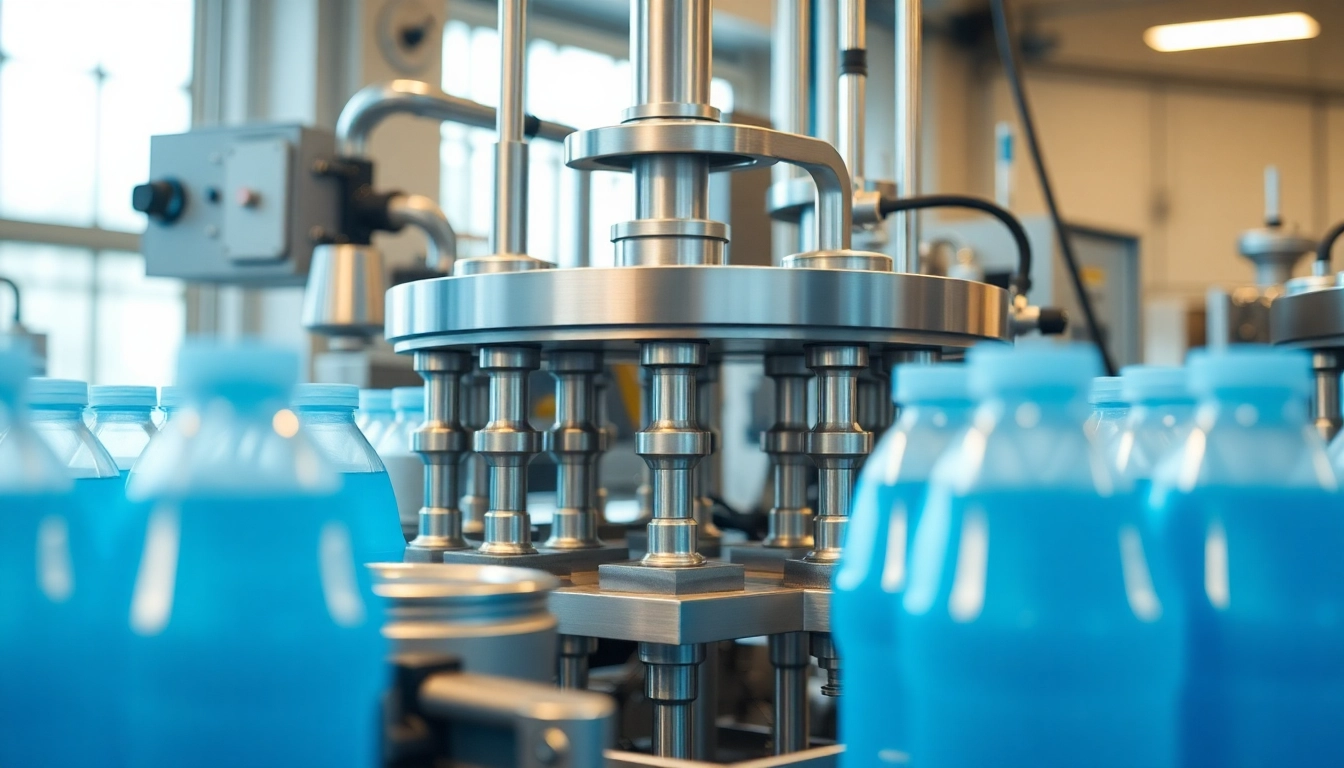Introduction to Liquid Packaging Machines
In the fast-paced world of manufacturing and distribution, efficiency is paramount. One area where this efficiency can greatly influence the bottom line is in packaging, specifically through the use of liquid packaging machines. These machines play a critical role in various industries, from food and beverage to pharmaceuticals and chemicals, ensuring products are packaged safely and efficiently. A reliable Liquid Packaging Machine Supplier can mean the difference between success and failure in these sectors, as they offer not just machines but an entire range of solutions tailored to specific business needs.
What is a Liquid Packaging Machine?
A liquid packaging machine is specialized equipment designed to fill, seal, and package liquid products into containers of various shapes and sizes. These machines can handle a wide variety of liquid products, including water, oils, juices, sauces, and even chemicals. The packaging process often includes filling the container, applying closures, and labeling, all of which can be automated to enhance production speed and consistency.
Types of Liquid Packaging Machines
Liquid packaging machines can be classified into several categories based on their design and functionality:
- Filling Machines: These are designed specifically for dispensing liquids into containers. They can be further divided into:
- Piston Fillers: Suitable for viscous liquids, offering precise filling volumes.
- Gravity Fillers: Ideal for thin liquids, relying on gravity to dispense product.
- Pump Fillers: Suitable for a variety of liquid viscosities and can handle thick liquids.
- Sealing Machines: These machines ensure that containers are sealed correctly after filling to prevent leakage.
- Labeling Machines: Automation of the labeling process to ensure accurate and efficient labeling of containers.
- Complete Packaging Lines: Integrated systems that combine multiple functions—filling, sealing, and labeling—into a single process.
Benefits of Using Liquid Packaging Machines
The adoption of liquid packaging machines comes with numerous benefits that can significantly enhance operational efficiency:
- Increased Efficiency: Automation reduces manual labor and speeds up the packaging process, ultimately increasing output.
- Consistent Quality: Precision engineering ensures that each package is filled and sealed to the same standards, reducing the risk of errors and waste.
- Versatility: Many machines can handle different types of liquids and containers, making it easier to change product lines without significant reconfiguration.
- Cost Savings: Streamlined processes and reduced labor costs can lead to considerable savings over time.
Choosing the Right Liquid Packaging Machine Supplier
Selecting an appropriate supplier for liquid packaging machines is crucial. The right partner can provide equipment, knowledge, and support to enhance your packaging operations. Here are some key factors to consider when making this important decision.
Key Factors to Consider
When evaluating potential suppliers, focus on the following aspects:
- Industry Experience: Suppliers with years of experience are often more reliable, as they have dealt with various client needs and market changes.
- Product Range: A diverse selection of machines can cater to various packaging needs, saving time for clients looking for multi-functional solutions.
- Technology and Innovation: A supplier that invests in the latest technology can offer updated machines that are efficient and cost-effective.
- Customization Options: The ability to customize machinery based on specific needs is essential in an industry where products vary widely.
Evaluating Supplier Credentials and Experience
Before committing to a liquid packaging machine supplier, it’s crucial to assess their credentials:
- Certifications and Standards: Verify that suppliers adhere to industry standards (ISO, CE certifications) to ensure safety and quality.
- Testimonials and Case Studies: Look for feedback from other companies that have used their machines to gauge reliability and performance.
- After-Sales Support: Quality support and maintenance services can significantly reduce downtime in operations.
Comparing Pricing and Services
Pricing should not be the only consideration when choosing a supplier; however, it remains an essential aspect. Compare not just machine costs but also:
- Warranty Terms: A good warranty reflects confidence in the product’s longevity.
- Service Agreements: Understand what maintenance services are offered post-purchase and how they align with your operations.
- Training for Operators: Adequate training can enhance operators’ effectiveness, reducing the likelihood of costly mistakes.
Applications of Liquid Packaging Machines
Liquid packaging machines serve a wide array of industries, each with its own unique requirements and challenges. Here’s a closer look at some prominent applications.
Food and Beverage Industry
The food and beverage sector relies heavily on liquid packaging machines for various products, including juices, sauces, oils, and dairy products. The machines help maintain product freshness and safety, with packaging techniques tailored to each product’s requirements. For instance:
- Juices: Often require precise filling to avoid overflow and ensure shelf stability.
- Dairy Products: Must be packaged under strict hygiene standards to prevent contamination.
Pharmaceutical Sector
In pharmaceuticals, liquid packaging machines ensure that medications are packaged reliably and safely. The importance of accuracy in dosage and adhering to regulations around sterile environments makes these machines indispensable. For example,:
- Vials and Ampoules: Require filling machines that can operate in cleanroom conditions.
- Syrups and Solutions: Must be filled without air bubbles to maintain product integrity.
Chemical and Industrial Use
Liquid packaging machines also find a vital application in the chemical industry, where products can range from solvents to oils. The following are key considerations in this sector:
- Hazardous Materials: Machines must be designed for safely handling and packaging potentially hazardous substances.
- Container Variation: These machines should effectively fill various types of industrial containers, from drums to small bottles.
Best Practices for Operating Liquid Packaging Machines
To maximize the efficiency and lifespan of liquid packaging machines, it’s essential to adopt best practices during operation.
Maintenance Tips for Longevity
Regular maintenance minimizes downtime and ensures that machines continue to perform optimally. Here are some actionable tips:
- Regular Cleaning: Cleaning the machines regularly prevents product buildup that can lead to malfunctions.
- Scheduled Inspections: Implement a schedule for part replacements and inspections, ensuring that any wear and tear are handled proactively.
Operational Efficiency Strategies
Improving operational efficiency is crucial in maximizing output. Consider the following strategies:
- Training Staff: Regular training sessions can keep your team skilled in handling and troubleshooting the machinery.
- Monitoring Performance: Use data analytics to monitor machine performance and productivity, identifying areas for improvement.
Safety Protocols and Best Practices
Ensuring safety in the workplace is paramount. Implement these practices to ensure a safe working environment:
- Wear Appropriate Protective Gear: Ensure all operators have the necessary safety equipment.
- Emergency Procedures: Establish clear emergency protocols and ensure employees are familiar with them.
The Future of Liquid Packaging Technology
The liquid packaging industry is continuously evolving, with innovations in technology and shifts in consumer demand shaping its future. Here, we explore emerging trends and developments.
Innovations in the Industry
Recent advancements in the field are focusing on automation, sustainability, and smart technologies:
- Smart Packaging: Integration of IoT technologies allowing for real-time monitoring of packaging processes and quality assurance.
- Automation: Increased use of robotics to handle packaging tasks, reducing labor costs and enhancing speed.
Environmental Considerations
As sustainability becomes a priority globally, liquid packaging solutions are increasingly focusing on eco-friendly practices:
- Biodegradable Materials: The push towards using biodegradable and recyclable materials in packaging is gaining momentum.
- Reducing Waste: Implementing lean manufacturing principles to minimize packaging waste.
Trends to Watch
Keeping an eye on trends that could influence the liquid packaging market is crucial for staying ahead. Here are a few trends worth noting:
- Customization Options: Consumers are increasingly seeking personalized products, leading to machines capable of multi-product runs.
- Health-Conscious Packaging: With a growing emphasis on health, packaging that promotes nutritional information and product safety is becoming more prevalent.



